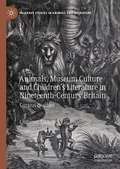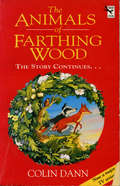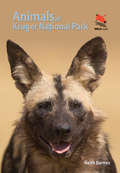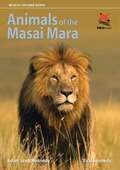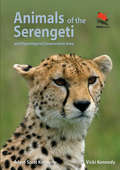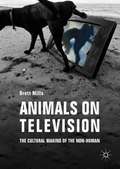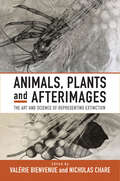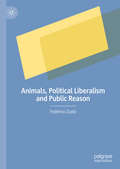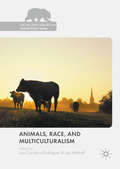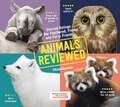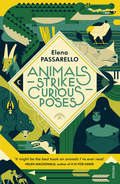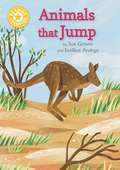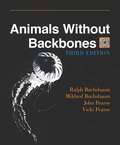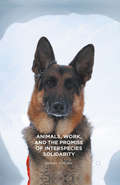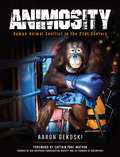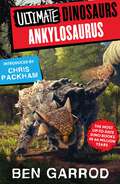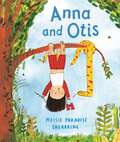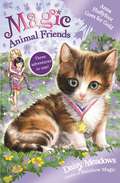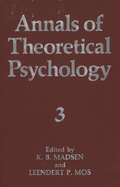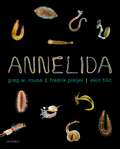- Table View
- List View
Animals, Museum Culture and Children’s Literature in Nineteenth-Century Britain: Curious Beasties (Palgrave Studies in Animals and Literature)
by Laurence TalairachAnimals, Museum Culture and Children’s Literature in Nineteenth-Century Britain: Curious Beasties explores the relationship between the zoological and palaeontological specimens brought back from around the world in the long nineteenth century—be they alive, stuffed or fossilised—and the development of children’s literature at this time. Children’s literature emerged as dizzying numbers of new species flooded into Britain with scientific expeditions, from giraffes and hippopotami to kangaroos, wombats, platypuses or sloths. As the book argues, late Georgian, Victorian and Edwardian children’s writers took part in the urge for mass education and presented the world and its curious creatures to children, often borrowing from their museum culture and its objects to map out that world. This original exploration illuminates how children’s literature dealt with the new ordering of the world, offering a unique viewpoint on the construction of science in the long nineteenth century.
The Animals Of Farthing Wood: The Story Continues....
by Colin DannAfter their legendary journey out of danger and into the safe haven of White Deer Park, the animals of Farthing Wood look forward to getting used to their new life in the nature reserve.But winter is drawing in: the nights are colder and food for the animals is scarce. Other animals in the park are unfriendly and want to make trouble, and around the Park there are the perils of hunters' traps, as well as humans and their machines. Will life ever return to normal for the animals of Farthing Wood...?
Animals of Kruger National Park (PDF)
by Keith BarnesSouth Africa's Kruger National Park is one of the largest and most diverse conservation areas in Africa, and a hugely popular visitor attraction. Animals of Kruger National Park is a compact and beautifully illustrated guide, and the essential companion for any safari to the region. With an eye-catching design, authoritative and accessible text and easy-to-use format, this detailed photographic guide provides information on identification, habitat, behaviour, biology and conservation for all the mammals, reptiles and frogs likely to be seen. Introductory sections provide background information on the park and its habitats, when to visit and where to go, and other practical considerations that will help to enhance your understanding, appreciation and enjoyment of the animals of this incredible region. The essential all-in-one Kruger safari companion, ideal for all visitors Unique and attractive layout, featuring 216 stunning colour photographs, 116 track (spoor) illustrations and two maps Covers 57 mammals, 17 reptiles and eight frogs Features the ‘Big 5’—elephants, leopards, lions, rhinoceroses and buffalos—as well as other iconic and charismatic animals Provides key information on identification, behaviour, biology and conservation
Animals of the Masai Mara (PDF)
by Adam Scott Kennedy Vicki KennedyOne of the greatest attractions of a trip to Kenya is the chance to see animals such as lions, cheetah, leopards, zebra, and giraffe up close and in their natural habitats. Animals of the Masai Mara is a lavish photographic guide that explores the charismatic wildlife most likely to be encountered by a safari visitor to the Masai Mara National Reserve in southwest Kenya. More than 140 stunning photographs showcase 65 mammals and 17 reptile species, including 6 snakes. Designed to be informative and locally accurate, rather than purely identification-based, this easy-to-use book pays particular attention to wildlife behavior and is written from the firsthand experiences of the authors and the knowledge of local safari guides. Numerous "Top Tips" throughout show readers how and where to locate specific species. The only field guide to focus solely on the wildlife of the Masai Mara National Reserve, Animals of the Masai Mara will be indispensable to visitors to this famous park and all nature enthusiasts with an interest in this area of the world. The only photographic guide specific to the animals of the Masai Mara National Reserve More than 140 remarkable photographs covering 65 mammals and 17 reptile species, including 6 snakes Accessible text explores animal behavior and other interesting facts A brief and informative introduction to the habitats of the Masai Mara
Animals of the Serengeti: And Ngorongoro Conservation Area (PDF)
by Adam Scott Kennedy Vicki KennedyContaining 146 stunning color photos, Animals of the Serengeti is a remarkable look at the mammals and reptiles most likely to be encountered in the world-famous Serengeti National Park and Ngorongoro Crater. With an eye-catching layout, accessible text, and easy-to-use format, this detailed photographic guide includes 89 species of mammal and reptile. Useful "Top Tips"—shared by local Tanzanian guides that work in the region—provide visitors with insights into behavioral habits and how to locate specific animals. Filled with vivid anecdotes, Animals of the Serengeti will enable any safari traveler to identify the area's wildlife with ease.Covers the 89 species likely to be encountered in Tanzania’s Serengeti National Park and Ngorongoro Conservation Area Features male and female variationsAccessible text aimed at safari visitors of all levels
Animals On Television: The Cultural Making Of The Non-human
by Brett MillsThis book is the first in-depth study of the representation of animals on television. It explores the variety of ways animals are represented in audio-visual media, including wildlife documentaries and children's animated series, and the consequences these representations have for those species. Brett Mills discusses key ideas and approaches essential for thinking about animals drawing on relevant debates in philosophy, politics, gender studies, humanism and posthumanism, and ethics. The chapters examine different animal representations, focusing on zoos, pets, wildlife and meat. They present case studies, including discussions of Peppa Pig, The Hunt and The Dog Whisperer. This book will be of interest to readers exploring media studies, contemporary television, animal studies, and debates about representation.
Animals On Television: The Cultural Making Of The Non-human (PDF)
by Brett MillsThis book is the first in-depth study of the representation of animals on television. It explores the variety of ways animals are represented in audio-visual media, including wildlife documentaries and children's animated series, and the consequences these representations have for those species. Brett Mills discusses key ideas and approaches essential for thinking about animals drawing on relevant debates in philosophy, politics, gender studies, humanism and posthumanism, and ethics. The chapters examine different animal representations, focusing on zoos, pets, wildlife and meat. They present case studies, including discussions of Peppa Pig, The Hunt and The Dog Whisperer. This book will be of interest to readers exploring media studies, contemporary television, animal studies, and debates about representation.
Animals, Plants and Afterimages: The Art and Science of Representing Extinction
by Valérie Bienvenue Nicholas ChareThe sixth mass extinction or Anthropocene extinction is one of the most pervasive issues of our time. Animals, Plants and Afterimages brings together leading scholars in the humanities and life sciences to explore how extinct species are represented in art and visual culture, with a special emphasis on museums. Engaging with celebrated cases of vanished species such as the quagga and the thylacine as well as less well-known examples of animals and plants, these essays explore how representations of recent and ancient extinctions help advance scientific understanding and speak to contemporary ecological and environmental concerns.
Animals, Plants and Afterimages: The Art and Science of Representing Extinction
by Nicholas Chare Valérie BienvenueThe sixth mass extinction or Anthropocene extinction is one of the most pervasive issues of our time. Animals, Plants and Afterimages brings together leading scholars in the humanities and life sciences to explore how extinct species are represented in art and visual culture, with a special emphasis on museums. Engaging with celebrated cases of vanished species such as the quagga and the thylacine as well as less well-known examples of animals and plants, these essays explore how representations of recent and ancient extinctions help advance scientific understanding and speak to contemporary ecological and environmental concerns.
Animals, Political Liberalism and Public Reason
by Federico ZuoloThis book explores the problem of disagreement concerning the treatment of animals in a liberal society. Current laws include an unprecedented concern for animal welfare, yet disagreement remains pervasive. This issue has so far been neglected both in political philosophy and animal ethics. Although starting from disagreement has been the hallmark of many politically liberal theories, none have been devoted to the treatment of animals, and conversely, most theories in animal ethics do not take the disagreement on this issue seriously. Bridging this divide with a change of perspective, Zuolo argues that we should begin from the disagreement on the moral status of animals and the treatment we owe them. Reconstructing the epistemic nature of disagreement about animals, Zuolo proposes a novel form of public justification to find principles acceptable to all. By setting out a unified framework which honours the liberal principles of respect for diversity, a robust liberal political theory capable of dealing with diverse forms of disagreement, and even some forms of radical dissent, is achieved.
Animals, Race, and Multiculturalism (The Palgrave Macmillan Animal Ethics Series)
by Luís Cordeiro-Rodrigues Les MitchellThis book focuses on multiculturalism, racism and the interests of nonhuman animals. Each are, in their own right, rapidly growing and controversial fields of enquiry, but how do multiculturalism and racism intersect with the debate concerning animals and their interests? This a deceptively simple question but on that is becoming ever more pressing as we examine our societal practices in a pluralistic world. Collating the work of a diverse group of academics from across the world, the book includes writing on a wide range of subjects and addressing contemporary issues in this critical arena. Subjects covered include multiculturalism, group rights and the limits of tolerance; ethnocentrism and animals; racism and discrimination and non-Western alternatives to animal rights and welfare. The book will be of interest to researchers, lecturers and advanced students as well as range of social justice organisations, government institutions, animal activist organisations and environmental groups.
Animals Reviewed: Starred Ratings of Our Feathered, Finned, and Furry Friends
by Association of Zoos and AquariumsZookeepers hilariously review the animals in their keep—from the anxious aardvark to the zealous zebra shark and every animal in between.
Animals Strike Curious Poses
by Elena PassarelloBeginning with Yuka, a 39,000-year-old mummified woolly mammoth recently found in the Siberian permafrost, each of the sixteen essays in Animals Strike Curious Poses investigates a different famous animal named and immortalised by humans. Here are the starling that inspired Mozart with its song, Darwin’s tortoise Harriet, and in an extraordinary essay, Jumbo the elephant (and how they tried to electrocute him). Modelled loosely on a medieval bestiary, these witty , playful, provocative essays traverse history, myth, science and more, introducing a stunning new writer to British readers.
Animals that Jump: Independent Reading Yellow 3 Non-fiction (Reading Champion #515)
by Sue GravesNo synopsis available.
Animals Without Backbones: An Introduction to the Invertebrates (New Plan Texts at the University of Chicago)
by Ralph Buchsbaum Mildred Buchsbaum John Pearse Vicki PearseAnimals Without Backbones has been considered a classic among biology textbooks since it was first published to great acclaim in 1938. It was the first biology textbook ever reviewed by Time and was also featured with illustrations in Life. Harvard, Stanford, the University of Chicago, and more than eighty other colleges and universities adopted it for use in courses. Since then, its clear explanations and ample illustrations have continued to introduce hundreds of thousands of students and general readers around the world to jellyfishes, corals, flatworms, squids, starfishes, spiders, grasshoppers, and the other invertebrates that make up ninety-seven percent of the animal kingdom. This new edition has been completely rewritten and redesigned, but it retains the same clarity and careful scholarship that have earned this book its continuing readership for half a century. It is even more lavishly illustrated than earlier editions, incorporating many new drawings and photographs. Informative, concise legends that form an integral part of the text accompany the illustrations. The text has been updated to include findings from recent research. Eschewing pure morphology, the authors use each group of animals to introduce one or more biological principles. In recent decades, courses and texts on invertebrate zoology at many universities have been available only for advanced biology majors specializing in this area. The Third Edition of Animals Without Backbones remains an ideal introduction to invertebrates for lower-level biology majors, nonmajors, students in paleontology and other related fields, junior college and advanced high school students, and the general reader who pursues the rewarding study of the natural world.
Animals Without Backbones: An Introduction to the Invertebrates (New Plan Texts at the University of Chicago)
by Ralph Buchsbaum Mildred Buchsbaum John Pearse Vicki PearseAnimals Without Backbones has been considered a classic among biology textbooks since it was first published to great acclaim in 1938. It was the first biology textbook ever reviewed by Time and was also featured with illustrations in Life. Harvard, Stanford, the University of Chicago, and more than eighty other colleges and universities adopted it for use in courses. Since then, its clear explanations and ample illustrations have continued to introduce hundreds of thousands of students and general readers around the world to jellyfishes, corals, flatworms, squids, starfishes, spiders, grasshoppers, and the other invertebrates that make up ninety-seven percent of the animal kingdom. This new edition has been completely rewritten and redesigned, but it retains the same clarity and careful scholarship that have earned this book its continuing readership for half a century. It is even more lavishly illustrated than earlier editions, incorporating many new drawings and photographs. Informative, concise legends that form an integral part of the text accompany the illustrations. The text has been updated to include findings from recent research. Eschewing pure morphology, the authors use each group of animals to introduce one or more biological principles. In recent decades, courses and texts on invertebrate zoology at many universities have been available only for advanced biology majors specializing in this area. The Third Edition of Animals Without Backbones remains an ideal introduction to invertebrates for lower-level biology majors, nonmajors, students in paleontology and other related fields, junior college and advanced high school students, and the general reader who pursues the rewarding study of the natural world.
Animals Without Backbones: An Introduction to the Invertebrates (New Plan Texts at the University of Chicago)
by Ralph Buchsbaum Mildred Buchsbaum John Pearse Vicki PearseAnimals Without Backbones has been considered a classic among biology textbooks since it was first published to great acclaim in 1938. It was the first biology textbook ever reviewed by Time and was also featured with illustrations in Life. Harvard, Stanford, the University of Chicago, and more than eighty other colleges and universities adopted it for use in courses. Since then, its clear explanations and ample illustrations have continued to introduce hundreds of thousands of students and general readers around the world to jellyfishes, corals, flatworms, squids, starfishes, spiders, grasshoppers, and the other invertebrates that make up ninety-seven percent of the animal kingdom. This new edition has been completely rewritten and redesigned, but it retains the same clarity and careful scholarship that have earned this book its continuing readership for half a century. It is even more lavishly illustrated than earlier editions, incorporating many new drawings and photographs. Informative, concise legends that form an integral part of the text accompany the illustrations. The text has been updated to include findings from recent research. Eschewing pure morphology, the authors use each group of animals to introduce one or more biological principles. In recent decades, courses and texts on invertebrate zoology at many universities have been available only for advanced biology majors specializing in this area. The Third Edition of Animals Without Backbones remains an ideal introduction to invertebrates for lower-level biology majors, nonmajors, students in paleontology and other related fields, junior college and advanced high school students, and the general reader who pursues the rewarding study of the natural world.
Animals Without Backbones: An Introduction to the Invertebrates (New Plan Texts at the University of Chicago)
by Ralph Buchsbaum Mildred Buchsbaum John Pearse Vicki PearseAnimals Without Backbones has been considered a classic among biology textbooks since it was first published to great acclaim in 1938. It was the first biology textbook ever reviewed by Time and was also featured with illustrations in Life. Harvard, Stanford, the University of Chicago, and more than eighty other colleges and universities adopted it for use in courses. Since then, its clear explanations and ample illustrations have continued to introduce hundreds of thousands of students and general readers around the world to jellyfishes, corals, flatworms, squids, starfishes, spiders, grasshoppers, and the other invertebrates that make up ninety-seven percent of the animal kingdom. This new edition has been completely rewritten and redesigned, but it retains the same clarity and careful scholarship that have earned this book its continuing readership for half a century. It is even more lavishly illustrated than earlier editions, incorporating many new drawings and photographs. Informative, concise legends that form an integral part of the text accompany the illustrations. The text has been updated to include findings from recent research. Eschewing pure morphology, the authors use each group of animals to introduce one or more biological principles. In recent decades, courses and texts on invertebrate zoology at many universities have been available only for advanced biology majors specializing in this area. The Third Edition of Animals Without Backbones remains an ideal introduction to invertebrates for lower-level biology majors, nonmajors, students in paleontology and other related fields, junior college and advanced high school students, and the general reader who pursues the rewarding study of the natural world.
Animals, Work, and the Promise of Interspecies Solidarity
by Kendra CoulterIn this thought-provoking and innovative book, Kendra Coulter examines the diversity of work done with, by, and for animals. Interweaving human-animal studies, labor theories and research, and feminist political economy, Coulter develops a unique analysis of the accomplishments, complexities, problems, and possibilities of multispecies and interspecies labor. She fosters a nuanced, multi-faceted approach to labor that takes human and animal well-being seriously, and that challenges readers to not only think deeply and differently about animals and work, but to reflect on the potential for interspecies solidarity. The result is an engaging, expansive, and path-making text.
Animosity: Human-Animal Conflict in the 21st Century
by Aaron GekoskiThe world’s wildlife is in crisis.Globally, animals are being traded, hunted, poached, consumed and exploited to the point of extinction. This is their story, as told through the lens and eyes of Aaron ‘Bertie' Gekoski, an internationally acclaimed environmental photojournalist, who documents human-animal conflict in the most inhospitable places on Earth.ANIMOSITY is a collection of powerful photographs and absorbing tales from the frontline of conservation: from Cambodia’s dog-drowning dungeons and West Africa’s voodoo markets, to cruel Wildlife Tourism Attractions and the shadowy world of the exotic pet trade.Conflict, conservation, and the battle to coexist: ANIMOSITY is the story of our generation, our legacy.Numerous animal welfare NGOs have lent their backing to the book including Born Free Foundation, Four Paws, World Animal Protection, International Animal Rescue, PETA & Scubazoo, while world famous actresses Shannon Elizabeth and Amy Jackson have written moving testimonies for the book.The foreword has been written by one of the best-known environmental activists in the world, Captain Paul Watson, founder of the Sea Shepherd conservation society and a co-founder of Greenpeace.
Ankylosaurus (Ultimate Dinosaurs)
by Ben GarrodCovered in armoured plates and sharp spikes, weighing more than an elephant, and swinging a deadly tail club capable of smashing through bone, Ankylosaurus is an Ultimate Dinosaur. But one we know very little about. Why have so few of their skeletons been found? Could they really have used their tails to take down an attacking Tyrannosaurus rex? Find out about this indestructible dinosaur and 7 more in the Ultimate Dinosaurs series.Pop a dinosaur in your pocket! Introductions from Chris Packham, Steve Backshall and Dr Jane Goodall. These are the most up-to-date dino books in 66 million years, also available in audio download!TV scientist, Professor Ben Garrod, is proud to be a geek as he mixes top level science and humour to prove that science is for everyone. Looking at the evolutionary arms race, prey, predators, place, time, groups and species, Ben reveals new-look dinosaurs. Additional sections include: Ask an Expert, New Science and Fossil Finder as well as quizzes to test your dinosaur knowledge.'A celebration of everything that science is really about.' NatSCA'A perfect primer for kids to learn more about the amazing "terrible lizards".' BBC Wildlife Magazine'He's the man! The genius is his knowledge; the genius is the man himself!' Chris Evans, Virgin Radio Breakfast Show'Shines a fresh, contemporary light on this ever-popular topic.' The Bookseller'Collectable and eye-catching, with plenty of diagrams and illustrations.' Books for Keeps
Anna and Otis
by Maisie Paradise ShearringA hugely endearing, very funny story about kindness, friendship and overcoming fears, from award-winning illustrator Maisie Paradise Shearring.Anna and Otis the snake are great friends and they love having fun together. But Otis knows people are scared of snakes, so he usually just plays at home or in the garden. He is nervous when Anna suggests a new adventure. At first people are afraid, and Otis feels he isn't welcome in the town. But Anna encourages Otis not to give up, and it soon turns out that maybe snakes aren't as scary as people thought! The hairdresser enjoys shampooing a reptile for a change, and at the skate shop Sally has a lot of fun fitting Otis with his own set of awesome wheels. Anna and Otis is full of endless rich details to spot and Maisie's artwork is a treat to pore over.
Anna Fluffyfoot Goes for Gold: Special 6 (Magic Animal Friends #6)
by Daisy MeadowsAn enchanting series full of adorable animals, magic and friendship - from the creator of RAINBOW MAGIC, the UK's bestselling series for girls aged 5-7.In the magical land of Friendship Forest, the animals are getting ready for a sports day! But wicked Grizelda wants to spoil everyone's fun. Can best friends Lily and Jess help super-cute kitten Anna Fluffyfoot stop the witch's horrible plans, before the special day is ruined?
Annals of Theoretical Psychology: Volume 3
by K. B. Madsen Leendert P. MosAs a follow up to Volume 7, contributors continue to explore the latest developments in developmental psychology. Here, researchers focus on the integration of theory and research and evaluates theoretical progress and advanced research. Continuing with the successful format of previous volumes in Annals of Theoretical Psychology, Volume 10 presents four major contributions--each accompanied by commentaries and replies to commentaries.
Annelida
by Greg Rouse Fredrik Pleijel Ekin TilicAnnelids (the segmented worms) exist in a remarkably diverse range of mostly marine but also freshwater and terrestrial habitats, varying greatly in size and form. Annelida provides a fully updated and expanded taxonomic reference work which broadens the scope of the classic Polychaetes (OUP, 2001) to encompass wider groups including Clitellata (comprising more than a third of total annelid diversity), Sipuncula, and Thalassematidae (formerly Echiura). It reflects the enormous amount of research on these organisms that has burgeoned since the millennium, principally due to their use as model organisms to address wider and more general evolutionary and ecological questions. Beginning with a clear introduction to the phylum and an outline of annelid taxonomy, this authoritative text describes their collection, the methods to ensure their optimal preservation, and an overview of anatomy with its relevant terminology. The core of the work comprises 77 fully up-to-date taxonomic chapters, informed by anatomy and the latest molecular phylogenomic evidence and carefully organised based on a new, robust phylogenetic hypothesis. Lavishly illustrated throughout with hundreds of previously unpublished high-resolution colour images and SEM micrographs, the sheer beauty and diversity of the annelids is nowhere better presented. Annelida is the definitive reference work for annelid biologists, whilst being of interest to a broader audience of invertebrate zoologists, systematists, and organismal biologists.
